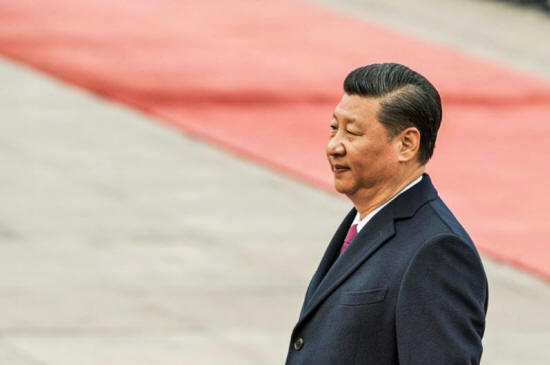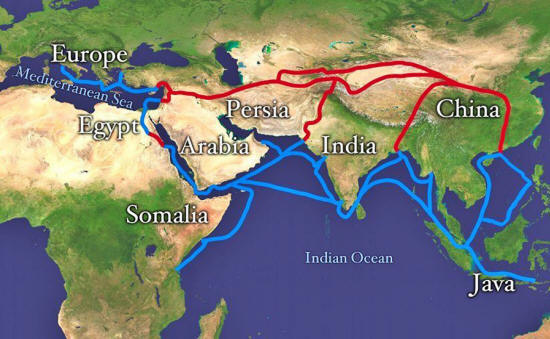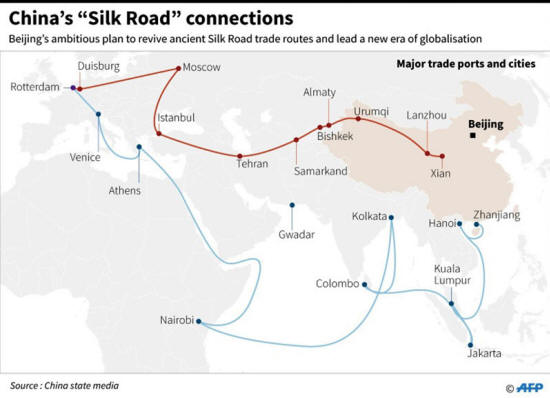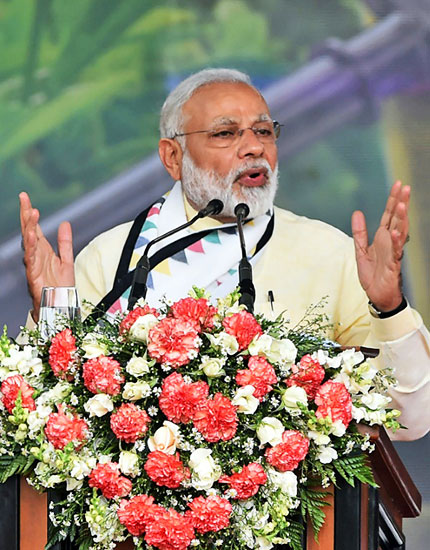|

by Laurent Thomet
May 13, 2017
from
BusinessInsider Website

President Xi Jinping
will
host leaders from 29 nations in Beijing
for a
two-day forum on his signature foreign policy program,
a
revival of the Silk Road dubbed the One Belt, One Road Initiative
© AFP/File
Fred DUFOUR
As Trump plays
the Protectionist card on global trade, China is
wasting no time in taking over the lead with
globalization.
It intends to
re-open the famous trade route called the Silk Road,
which connected Asia with Europe. Instead of dirt
roads and paths, the new "Belt
and Road" project will span 65 nations
and cost upwards of $1 Trillion.
However, it
will revolutionize global trade and give China a
wide-open door to Europe and the Mideast.
As a Technocracy, China will naturally seek to build
infrastructure to connect to as many trading centers
as possible. Belt and Road will be the largest
infrastructure ever undertaken.
Meanwhile,
Trump's hardline rhetoric against China during the
campaign cycle has turned to sawdust. China is
wasting no time to take advantage of it.
China was the Trilateral Commission's love child in
the 1970s, and they orchestrated the transformation
from a Communist dictatorship to a Technocracy.
There is a good
possibility that the ‘protectionist' movement in the
West is being manipulated in order for China to rise
to global leadership. If true, then the timing and
the result is perfect.
Source
China is
hosting a summit on the new 'Silk Road' - a massive global trade
project
Beijing (AFP)
Original news on AFP Website
China opens on Sunday a
summit to promote its massive global trade infrastructure project,
highlighting Beijing's ambitions to spearhead a new era of
globalization as Washington shifts toward inward-looking policies.
President Xi Jinping will host leaders from 29 nations in
Beijing for a two-day forum on his signature foreign policy program,
a revival of the Silk Road dubbed the One Belt, One Road
Initiative (OBOR.)
The Chinese-bankrolled project, unveiled in 2013, seeks to link the
country with Africa, Asia and Europe through an enormous network of
ports, railways, roads and industrial parks.

The Silk Road or Silk Route was an ancient network
of trade routes that were for centuries central to cultural
interaction
through regions of the Asian continent connecting the East and West
and stretching from the Korean peninsula and Japan
to the Mediterranean Sea.
Source
The initiative spans some 65 countries representing 60 percent of
the world population and around a third of global gross domestic
product. The
China Development Bank has
earmarked $890 billion for some 900 projects.
Belt and Road is seen as a practical solution to relieve China's
industrial overcapacity.
But it could also serve
Beijing's geopolitical ambitions.
"In my view, Belt and
Road is intended to create greater economic interdependence
between China and its neighbors, which Beijing hopes will
translate into increased political influence," said Bonnie
Glaser, director of the China Power Project at the
Washington-based Center for Strategic and International Studies.
"Xi Jinping wants China to become the dominant regional power in
an essentially Sino-centric order," Glaser told AFP.
The Chinese government
describes the initiative as a partnership.
"What we need is not
a hero that acts alone, but partners of cooperation that stick
together," Chinese Foreign Minister Wang Yi said recently.
One-way street?
State-run media has
worked hard to explain the project to the world.
The English-language newspaper
China Daily has bombarded social
media with quirky videos, including an American father telling his
daughter bedtime stories about Xi's program and children singing,
"We'll share the
goodness now, the Belt and Road is how."
But few Western leaders
are attending the event. The prime ministers of Italy, Spain and
Greece are expected, while Washington is sending a senior White
House adviser.
Xi is championing globalization at a time when the concept's
traditional leader, the United States, is focused on "America First"
under US President Donald Trump.
The two countries,
however, sealed a deal Friday for China to export cooked poultry to
America and resume US beef imports.

Map showing China’s ambitious plan
to revive the ancient Silk Road trade routes.
© AFP/File / Laurence CHU
Europe, meanwhile, is mired in Britain's looming EU exit.
"The structure of the
global economy is changing... In this situation we want to be
completely open and outward looking," said Zhang Xueliang,
economics professor at Shanghai University of Finance and
Economics.
At the same time, the
European Union has pressed China to practice what it preaches and
further open its own market.
"Hopefully (Belt and
Road) is not a one-way street but a two-way," said Joerg Wuttke,
president of the European chamber of commerce in Beijing.
Indian
concerns
Other leaders attending the summit include Russian President
Vladimir Putin and Turkey's Recep Tayyip Erdogan.
Among neighbors, Philippine President Rodrigo Duterte,
Pakistani Prime Minister Nawaz Sharif and a delegation from
North Korea are coming.
But Indian Prime Minister Narendra Modi did not confirm his
attendance.
India has voiced displeasure at the China-Pakistan Economic
Corridor, a Belt and Road project aimed at linking northwestern
China to the Arabian Sea.

India, whose Prime Minister narendra Modi
is seen May 12, 2017, has voiced displeasure at the China-Pakistan
Economic Corridor,
a Belt and Road project aimed at linking northwestern China to the
Arabian Sea
© AFP/File / Ishara S. KODIKARA
The route cuts through Gilgit and Baltistan in Pakistan-administered
Kashmir, disputed territory that India claims is illegally occupied.
Human Rights Watch raised concerns on Saturday about the
treatment of people along the new Silk Road route in Central Asian
nations with poor track records in infrastructure projects.
The US-based organization said Chinese authorities have,
"heightened
surveillance and repression to prevent potential unrest that
could impede" Belt and Road plans in the western Xinjiang
region.
|





